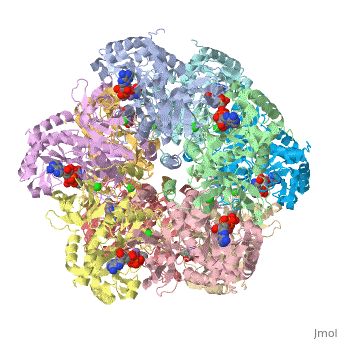User:Tom Gluick/Human Glutamine Synthetase
From Proteopedia
Contents |
Practice Page for Human Glutamine Synthetase
| |||||||||
| 2qc8, resolution 2.60Å () | |||||||||
|---|---|---|---|---|---|---|---|---|---|
| Ligands: | , , , | ||||||||
| Gene: | GLUL, GLNS (Homo sapiens) | ||||||||
| Activity: | Glutamate--ammonia ligase, with EC number 6.3.1.2 | ||||||||
| Related: | 2ojw | ||||||||
| |||||||||
| |||||||||
| Resources: | FirstGlance, OCA, RCSB, PDBsum | ||||||||
| Coordinates: | save as pdb, mmCIF, xml | ||||||||
Glutamine synthetase is a key component in the regulation of the concentration of nitrogen containing compounds through out the phyla. The enzyme synthesizes glutamine from glutamate, ATP, and ammonium ion via a two step mechanism involving an glutamyl-P intermediate. The ATP provides the driving force for the reaction by esterifying glutamate's C-3 carboxyl group with the γ-phosphate that is later displaced by ammonia. Glutamine is incorporated into proteins, serves as an energy source, is involved in assimilating ammonia to be used in amino acid and nucleic acid synthesis.
Quaternary Structure
The quaternary structure consists of ten identical subunits arranged as two pentameric rings stacked atop each other [1] as shown in the Java Applet on the right hand side of the page. Each subunit makes interacts with One notices that the quaternary interactions of one subunit involves half the complex, and that the contacts between Chain A with either E or B are extensive, but those with F or G are much fewer in comparison.
In the subpages that followUser:Tom_Gluick/Human_Glutamine_Synthetase/Quaternary Structure, a more extensive view of the subunit interactions is given. The are very extensive comprising a ## fraction of the entire surface area of the subunit. User:Tom_Gluick/Human_Glutamine_Synthetase/Quaternary Structure Interactions between subunit A and E is shown Quaternary interactions between subunit A to subunit F or to subunit G on the other ring.
Tertiary Structure
Each tertiary structure of each subunit consists ...; the red domain is ; and the blue domain is...
alpha beta
two domains
Catalytic domain--c- terminal
beat grasp domain. n-terminal
Secondary Structure
The composed of --- alpha helicesin pink, ----beta strandsin green, ---- and various types of turnsin white. The wiring diagram shown in PDBsum shows the secondary structure elements in an easily understood format.
Primary Structure and Catalytic Residues
Gln A signatures from analysis--select 62-79A or 62-79C or 62-79D or 62-79B or 62-79E rasmol command; seeProsite PS00180 (GLNA_1) The view shows a space-fill model similar to the one shown in prosite. A larger view showing the labeled residues with the signature is shown in this link/Large Image Showing Signature with labels. </br> Glutamine synthetase putative ATP binding site determined from analysis is ATP binding regions PS00181 select 241-257A or 241-257C or 241-257D or 241-257B or 241-257E
Enzyme Active Site
It is activated by Mn and several other divalent metal cations and α-keotglutarate; the enzyme is inhibited by methionine sulfoxime, glycine and carbamoyl phosphate.[1]
Disease State
Glutamine synthetase is a key component in controlling ammonia concentrations, maintaining nitrogen balance among organs, acid-base homeostasis, gene regulation and signaling.[2] Glutamine homeostasis is maintained in part via regulating transcription and GS protein degradation. [3].
In ureoteles, glutamine serves as a nontoxic shuttle of excess ammonia as its transported from tissues not capable of processing ammonia further through the blood to the liver where amide nitrogen eventually ends up in urea. For neurons in the brain to function normally, the excititory glutamate generated by the neuron is absorbed by the astrocyte and recycled to glutamine by GS.[4]
Disruptions in glutamine homeostasis brought about through cancer, trauma or HiV infection can lead to organ failure and death. Although extremely rare and only seen in the children of consnaguionoius couples, that defects in GLUL ( the gene encoding for gluatmine synthetase) causes a congenital disorder leading to brain malformation and death in neonates[2].[5]
Below the cartoon shown in the JMOL applet is a wealth of information linked to this site. Links immediately below provide views of ligands associated with the protein. Click on ADP or any other ligand in the green region will show cause the protein to become transparent revealing the buried ligand. Clicking on green link initial scene will return the image to the original scene. More information about the structure is found in the human glutamine synthetase stub[3] and references sited therein. This information can be also accessed by clicking the PFAM links in structural annotation resources. Clicking on the domains reveals the CCD database complied by NCBI. Images of the two GS domains can be visualized using this link. PDBsum and the RCSB links provide complementary information on ligand-protein interactions, protein-protein contacts, and literature citations as well as providing links to other resources.
Before you start the project, I suggest you view the video tutorial in [4] to provide you with the tools to get started and give you a great overview of the power of proteopedia. I also suggest that you be aware of scene authoring tools with detailed explanations link given in[5] and the editing page access in Help.
References
- ↑ Haussinger, D., & Schleiss, F., Glutamine metabolism and signaling in the liver, Forntiers in Bioscience 2007, 12, 371-391.
- ↑ Curi, R., Glutamine, gene expression, and cell function. Frontiers in Bioscience 2007 12: 344-357.
- ↑ Labow, B. I., et.al., Mechanisms Governing the Expression of the Enzymes of Glutamine Metabolism—Glutaminase and Glutamine Synthetase. J. Nutr. 2001 131: 2467S–2474S.
- ↑ Albrecht, J., Glutamine in the central nervous system: function and dysfunction. Frontiers in Bioscience 2007 12:332-343.
- ↑ Haberle, J., et.al., Congenital Glutamine Deficiency with Glutamine Synthetase Mutations. New Engl J Med 2003 353:1926-33.


